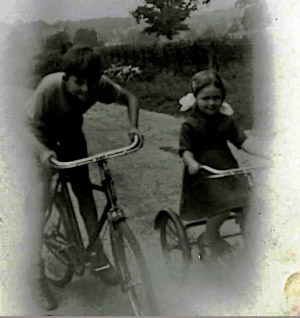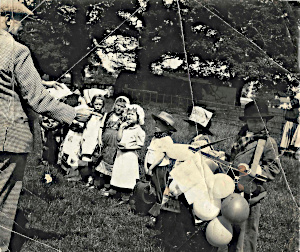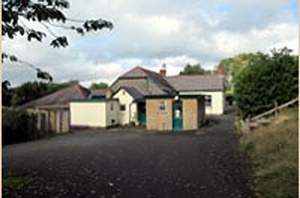Growing up in Glasbury
I was born in Glasbury on Christmas Eve, 1948, in a house called
Harrow Lodge. In those days home births – especially in
rural areas like Glasbury – were the norm. In the intervening
73 years Glasbury has changed enormously.
When I was growing up the village had 4 shops, 2 garages, a blacksmith,
a cobbler, 2 pubs (one also a hotel catering primarily for visiting
fishermen), 2 schools, a police station with resident sergeant,
a telephone exchange with a bank (on Fridays only!), 2 churches,
3 chapels (4 if you include Maesyronnen) and a functioning railway
station as well as a bus service. The stationmaster, Mr Miles,
lived on Brook Road – so called because of the brook running
its length. The brook has now disappeared, covered over –
I am not sure why.
The shops and facilities at the time were :-
Ralphs the Newsagents – they also sold sweets, ice creams
and some groceries. This was situated in the house now called
Grangeton.
The cobbler, Mr Bennet, had a little shop in the range opposite
the war memorial.
The Post Office, situated in Crescent House, opposite the entrance
to Glasbury House, run by Roche and Jean Morgan. They also sold
groceries and vegetables. Opposite the door, as you entered, was
a long counter; half was devoted to the Post Office section which
was fronted by a sort of mesh grille, with wooden shelves and
drawers ranged behind. The remainder of the counter was for the
shop. I well remember them cutting cheese from a large block with
a metal wire.
Mrs Meale’s grocery stores over the bridge, where the River
Café used to be. This was the largest of the grocery stores.
Mrs Jeffs’ sweet shop, just past the Harp Inn. The shop
was on the same level as the road and pavement. When you entered
a bell rang and Mrs Jeffs (who was a rather portly lady) had to
come up from her rooms on the floor below, which took some time.
I often wonder how many of the tempting sweets on display vanished
into little pockets during the time it took her to reach the shop!
Milk was delivered daily by a local farm but also by “Cookie”
who drove a Co-op van from Brecon; he delivered bread too –
the white, wrapped, sliced variety. Meat was delivered weekly
by van, as was fish.
One garage – Thomas’s Garage, which was opposite the
village hall, (which did not exist at that time) – has now
disappeared. They sold fuel, carried out repairs and ran a bus
and taxi service. When my grandparents arrived to visit us by
train they were always met at the station by Mrs Thomas in her
taxi. The blacksmith’s forge, situated opposite Brookside
and now a cottage, was part of the garage setup.
The hotel/pub was called the Maesllwch Arms. It had belonged to
the Maesllwch estate for many years and the hotel clientele mostly
comprised salmon fishermen who came to Glasbury for the excellent
fishing on offer. The estate sold the Maesllwch Arms in the 1960s
to Bulmers who put in a series of managers. The hotel had a good
reputation for many years and the pub was the centre of village
life. However, it later had a chequered history, at one time being
closed and boarded up, before eventually being sold and remodeled
as Foyles.
The other pub, the Harp, has also been remodeled. In the 1950s
and early 1960s it had a dark, smoky public bar to the left of
the door and a “saloon bar” (seldom used) to the right.
There was an “off-licence” window near what is now
the front door, where some of the village children went to buy
crisps. Later on they bought packets of 5 cigarettes – or
at least persuaded the older children to buy them on their behalf.
Both schools, Coed-y-Bolen and Ffynnongynydd, are sadly closed,
as is much else.
When I was young the road over the bridge from Hay to Llowes took
a different route; it turned down in front of the Scout Hut and
continued past the area where the retirement bungalows are; it
then turned right by Crescent House, to continue down Hampton
Road and on to Llowes . It now runs through what were fields which
housed the football pitch for the village team. Several cottages
on Hampton Road were demolished to make way for this new road.
The road from Cwmbach to Ffynnongynydd has also changed from its
original position close to the brook. Two houses were demolished
to make way for the current road – one was my family’s
home for several generations and the other was a laundry which
had ceased functioning as such by the time I was born.
There were a lot of children in the village in those days and
we all played together. The usual meeting point was between the
Maesllwch Arms (now Foyles) and the council houses (now Plough
Cottages). This was the start of one of the drives up to the Castle
where there were 2 pillars and some wrought iron gates. The gates,
which were never closed, had been a coming of age present to Walter
de Winton in February 1914, paid for by the tenants of the Maesllwch
estate. We had great fun climbing up the ivy covered pillars.
We played a variety of games: kick the tin (a variation on hide
and seek); French cricket, marbles, conkers, L O N D O N spells
London etc. In the summer we spent a lot of time at the river
– the boys jumping into the river from the bridge or swinging
out on a rope and then jumping in, swimming across or just fishing
for tiddlers with jam jars. The Bont in those days was grazed
by sheep so there were few trees. The Big Meadows were all open
and free for villagers to make use of. We sometimes had picnics
there, near the fishermen’s hut, and my father would swim
across the river with one of us children on his back. I was horrified
to see that whoever farms the land now has fenced it all off,
leaving just a right of way.
Every summer the children of the village, together with their
mothers, went on a free trip to the seaside. This was called the
Bagshawe outing as the money to pay for it had been left in trust
by Mr Ernest Bagshawe. The destinations were Barry Island, Porthcawl,
the Mumbles – in rotation. And how excited we were! Everyone
wanted to bag the back seat – but the older children invariably
won – and there was great competition to be the first to
see the sea. I remember some really wet trips to the seaside which
resulted in a visit to the cinema rather than a dip in the sea.
On the return journey a hat was handed round to collect a tip
for our driver and we all sang “For He’s a Jolly Good
Fellow”, arriving home tired but happy.
Another highlight of the summer was the annual fete and carnival
held in Maesllwch Park, near the old cricket pavilion. This was
a very well attended affair with people coming from the towns
and villages around to take part. There were fancy dress competitions
for various ages, a competition for the best decorated bicycle
or pram (we used miles of crepe paper for this), races –
three-legged race, sack race, apple bobbing as well as sprinting
– and many other games and entertainments such as a Punch
and Judy Show. For the adults there was a tug of war and an event
that involved balancing on a smooth, shiny pole, which was supported
at either end, and hitting your opponent with a sack filled with
hay or straw or something similar. It was difficult enough to
balance on the pole and stay upright, without being hit!
In the Autumn the village children were allowed to take part in
the potato picking on the estate alongside people who came from
Hay and other areas to earn some money. This was really hard work
and the adults complained bitterly if we, children, were slow
and delayed the tractor that was bringing the potatoes to the
surface. Even though it was hard work we were glad of the opportunity
to earn some money.
Schooldays
I went to Coed-y-Bolen school, starting in the September before
my 4th birthday, and loved my time there. The majority of the
village children went to this school, others going to Llowes and
Boughrood schools. We walked there together, the older children
taking care of the younger, picking wild flowers in the summer
and conkers in the autumn. There were 3 classes – the Infants,
in the tender care of Miss Coles, the Juniors in the not-so tender
care of Miss Jones and the Seniors in the capable hands of the
Headmaster, Mr Evans. There were about 70 pupils there in those
days and we had a huge expanse of ground on which to play - unsupervised.
There was the schoolyard itself and between the yard and the road
a large, open area of grass, with trees and ferns to either side.
Below us was the railway line, with no fence between the school
grounds and the track - something unthinkable in today’s
health and safety conscious times - but no-one came to any harm.
We learned times tables by rote, as well as reciting the catechism
– something we had to learn in order to be examined for
our Bishop’s certificates (Coed-y-Bolen was a church school).
In the Junior and Senior classes we sat in wooden, double desks,
with lids that lifted and ink wells in the corner. How well I
remember using those awful wooden pens with the scratchy nibs.
The nit nurse visited regularly, examining our heads and hands.
The school dentist would arrive once a year with a white caravan
– I dreaded his visit as I invariably needed treatment.
I seem to remember fillings without anaesthetic but I am not certain
about this! We always had a half day’s holiday for St David’s
Day. At the end of the winter term we had a Christmas party –
sandwiches, cups of tea, cakes, jelly and ice-cream – and
our parents came to watch us dance. For dancing we had to wear
black plimsolls (“daps” as we called them –
a word that always got me into trouble with my mother; I was supposed
to call them plimsolls) selected from a heap; you had to find
a pair that fitted as closely as possible. I sat my 11+ exam on
a Saturday morning in Clyro Court which was then a secondary modern
school. It was with great sadness that I left Coed-y-Bolen to
attend the Grammar School in Llandrindod Wells. In those days
the river divided the village into Radnorshire and Breconshire;
I lived on the Radnorshire side so my grammar school was a journey
of 24 miles each way whereas the Breconshire children had a journey
of half the distance.
I left Glasbury at the age of 18; it was a lovely village in which
to grow up and I am grateful that I had that experience.
Christine Forbes - October 8th 2022
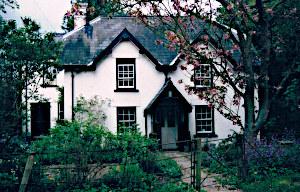
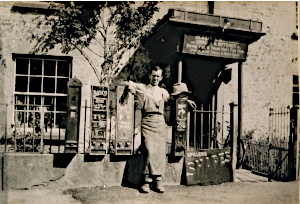
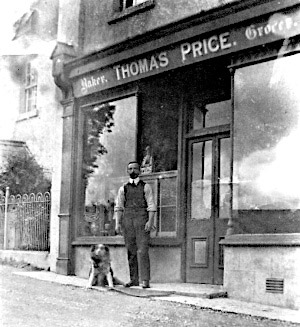 Gill Little's grandfather Thomas
Price, who owned the
Gill Little's grandfather Thomas
Price, who owned the